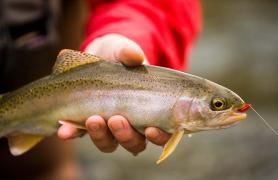What image comes to mind when you hear the word wetland? Do you immediately picture cattails or ducks and geese feeding in the shallow water? What sounds do you hear? The buzzing hum of mosquito wings?
The splashing and grunting sounds of contented ducks? Or perhaps a red winged blackbird calling repetitively from the top of the tallest rush or willow?
What you may not realize is there is so much more going on in wetland ecosystems than you can see and hear.
Many species, such as small, amazing insects, crayfish, and amphibians, live much of their lives in wetlands and are rarely seen or heard. There is even a group of wetland birds that are infrequently seen or heard because of their elusive behavior, cryptic coloration, and infrequent calls.
What’s in a Name?
These elusive and cryptic birds, known as “secretive marsh birds,” include rails, bitterns, coots, and grebes, some of which breed in Missouri while others just stop here temporarily during fall and spring migration. Fall-migrating marsh birds stop in Missouri wetlands in August through November to fuel up before continuing on their 1,000- plus mile annual journey from their breeding grounds in the northern U.S. and southern Canada to their wintering grounds on the Gulf Coast of Mexico and farther south. They stop in Missouri again the following spring as they make the reverse trip from their wintering grounds back north where they will initiate a nest and hopefully raise their young before the summer breeding season is over.
Secretive marsh birds are among the least-studied birds in North America because their elusive behavior and, well, secretive ways make them very difficult to observe. This has contributed to a lack of understanding about their migratory movements and habitat selections when they stop to refuel at places like Missouri wetlands. Despite these challenges, marsh birds are worth learning more about because they can help us better understand how wetlands function and what management actions are needed to ensure they leave Missouri in as good or better shape than when they arrived. For example, different species of rails, such as sora and Virginia rails, use different types of wetlands as they travel across countries during their migration. Their presence can serve as an indicator of a wetland’s general health. They are also a great rallying point for birders and hunters alike, since, as they seasonally pass through the state, rails are sought after by both groups.
Discovering the Unexpected
Because marsh birds are so poorly studied, there are many aspects of their lives and habitat requirements that we don’t know about and await discovery by keen-eyed observers. One such discovery occurred when Auriel Fournier, then a graduate student at the University of Arkansas and researcher with MDC, saw a sora rail dive and swim underwater.
This occurred when she heard her technicians shouting across the wetland one night while capturing rails. Her technicians had just tried to capture a sora, and it dove under the water to get away from them, then popped up several yards away.
After this encounter, Fournier and her team observed this unusual sora behavior several times, eventually capturing it on video for the first time anywhere. It will be published in the Wilson Journal of Ornithology later this year.
Secrets to Uncover
There are many other mysteries to discover and questions to answer regarding secretive marsh birds. MDC is committed to managing wetlands across the state to support all plants and animals that rely on these unique habitats, including marsh birds. One of the best ways to detect marsh birds is by playing a recording of their calls in spring.
The birds typically answer the recorded calls during this time of year, revealing their presence. However, it’s only been in the past few decades that technology has produced devices small enough to easily carry into the marsh. Additionally, the recent development of standardized survey protocols has enabled researchers to compare results from one study area to another to learn more quickly about marsh bird habitat needs.
MDC, the U.S. Fish and Wildlife Service, and the USGS Missouri and Arkansas Cooperative Fish and Wildlife Research Units collaborated on two secretive marsh bird projects. One project focused on spring migration and the breeding season, and the other focused on fall migration.
Spring Migration and Breeding Study
The spring portion of the study, conducted by University of Missouri graduate student Evan Hill, focused on understanding what wetlands the birds used during spring migration and how habitat conditions and management decisions in those wetlands influenced the birds’ use. To locate secretive marsh birds, Hill and his technicians did over 1,600 call-back surveys at eight department-owned conservation areas and four national wildlife refuges across Missouri in spring 2013 and 2014. They heard and, in a few cases, saw approximately 1,400 secretive marsh birds, including sora rail, Virginia rail, king rail, least bittern, and American bittern. According to the study, sora were attracted to wetlands where water levels were drawn down slowly and remained through mid-April, whereas least bittern preferred wetlands with water drawdowns that were initiated in mid- to late-May. American bittern presence increased with slower drawdowns, with water present through May, later drawdowns (initiated in July), and deeper water (more than 5 feet).
Hill’s team also searched wetlands for nesting marsh birds and found 71 least bittern nests, all of which were located in persistent emergent vegetation, such as cattail or bulrush. Least bitterns rely on this vegetation to build nest platforms above the water’s surface, which helps provide refuge from predators. Least bitterns are the smallest member of the heron family and are unable to wade in deep water, so they cling to the robust vegetation. They are able to move around a wetland and forage at deeper water depths than other wading birds that walk through the wetland. Approximately 60 percent of least bittern nests were successful — which means at least one chick per nest fledged — and nests were more likely to be successful at water depths that ranged from 1.5 to 3 feet deep.
Fall Migration Study
Rails fall migration is especially difficult to study because, unlike in spring, when you can broadcast the calls of a rail and increase your chances of hearing or seeing them, the birds don’t usually vocalize this time of year. Therefore, in order to find the birds, Fournier had to find another way of increasing the chances of finding them. This is why she and her team were in a wetland in the middle of the night. It turns out it’s easier to find a rail at night during fall migration.
By doing nocturnal surveys, Fournier and her technicians were able to observe approximately 8,000 rails over the past five years, including three species — sora, Virginia, and yellow rails. Soras are by far the most abundant, arriving in Missouri in early August and passing through until early November. Yellow and Virginia rails have a shorter migration, arriving in mid-September and migrating until late October, and are much less abundant.
While the location of these three rails overlaps in Missouri, they often use slightly different habitats, even within the same wetland. Soras are generalists, spreading out over a wide range of wetland conditions, from drier areas to deep water. They often occur at the highest densities in areas with shallow water depths and dense vegetation, like smartweed and wild millet, that produce large numbers of seeds. Yellow rails use shallower areas with dense vegetation. They avoid deep water areas, preferring places where the ground is just moist. Virginia rails can be found somewhere in between these conditions, preferring shallow water depths, with a tendency toward areas containing tall wetland vegetation, such as cattails, instead of the shorter, seed-producing plants.
A Balancing Act
Wetland management is part science and part art — combining the information learned from research projects, like the marsh bird studies, with the experience and knowledge of local managers. This balance ensures that the department continually improves how it makes decisions and uses information. Understanding when species use different habitats and for how long helps wetland managers make better informed decisions, which benefits the entire ecosystem and all the species that may use the wetland, whether those are rails, waterfowl, or frogs.
Think back to your initial image of a wetland and see if it has changed. Now, perhaps you are picturing some of those less-seen and -heard critters. Perhaps, the next time you visit a wetland, you’ll arrive with increased awareness that there is more than meets the eye as you look across the seemingly empty pool of water. Maybe you’ll be on the lookout for a shy marsh bird hiding in the wetland plants as it refuels before continuing with its spring or fall migration. These marvelous marsh birds and many other amazing creatures await your discovery in our wondrous Missouri wetlands.
It’s All About the Mouth and Feet
During my undergraduate studies, I took a Natural History of Vertebrates course taught by Dr. Ernest E. Provost, who was well-known as a tough, but extremely knowledgeable teacher. He often told us, “If you want to know how an animal makes its living, look at its mouth and feet. They have the most contact with the environment and will tell you what you need to know.” Dr. Provost was infamous for an ornithological test he once conducted because he did not think his students were listening to his advice. They arrived for their lab test and found all the bird specimens covered by paper bags. They were required to identify each bird based simply on their feet. This may sound a bit extreme, but it really is doable. You can learn a lot by looking at an animal’s feet.
Many wetland-dependent birds, such as ducks, geese, and swans, have webbed feet, which enable them to easily swim through water. A sora, on the other hand, has virtually no webbing on its feet, but rather has long toes that can spread wide apart. This configuration is helpful in distributing the bird’s light body weight as it walks across lily pads, soft mud, and otherwise maneuvers through a wet, soggy environment. However, these feet give no clue that swimming underwater would be a strategy that worked for a sora escaping a potential predator or a curious researcher.
—Doreen Mengel






















Also In This Issue


And More...
This Issue's Staff
Associate Editor - Bonnie Chasteen
Staff Writer - Larry Archer
Staff Writer - Heather Feeler
Staff Writer - Kristie Hilgedick
Staff Writer - Joe Jerek
Creative Director - Stephanie Thurber
Art Director - Cliff White
Designer - Les Fortenberry
Designer - Marci Porter
Photographer - Noppadol Paothong
Photographer - David Stonner
Circulation - Laura Scheuler






















